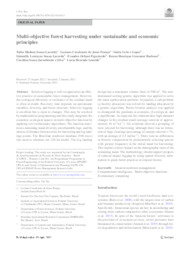Multi?objective forest harvesting under sustainable and economic principles.
Multi?objective forest harvesting under sustainable and economic principles.
Autoria: LACERDA, T. H. S.; FRANÇA, L. C. de J.; LOPES, I. L. e; LACERDA, S. L. S.; FIGUEIREDO, E. O.; BARBOSA, B. H. G.; SILVA, C. S. J. e; GOMIDE, L. R.
Resumo: Selective logging is well-recognized as an efective practice in sustainable forest management. However, the ecological efciency or resilience of the residual stand is often in doubt. Recovery time depends on operational variables, diversity, and forest structure. Selective logging is excellent but is open to changes. This may be resolved by mathematical programming and this study integrates the economic-ecological aspects in multi-objective function by applying two evolutionary algorithms. The function maximizes remaining stand diversity, merchantable logs, and the inverse of distance between trees for harvesting and log landings points. The Brazilian rainforest database (566 trees) was used to simulate our 216-ha model. The log landing design has a maximum volume limit of 500 m3 . The nondominated sorting genetic algorithm was applied to solve the main optimization problem. In parallel, a sub-problem (p-facility allocation) was solved for landing allocation by a genetic algorithm. Pareto frontier analysis was applied to distinguish the gradients ?-economic, ?-ecological, and ?-equilibrium. As expected, the solutions have high diameter changes in the residual stand (average removal of approximately 16 m3 ha?1). All solutions showed a grouping of trees selected for harvesting, although there was no formation of large clearings (percentage of canopy removal<7%, with an average of 2.5 ind ha?1). There were no diferences in foristic composition by preferentially selecting species with greater frequency in the initial stand for harvesting. This implies a lower impact on the demographic rates of the remaining stand. The methodology should support projects of reduced impact logging by using spatial-diversity information to guide better practices in tropical forests.
Ano de publicação: 2023
Tipo de publicação: Artigo de periódico
Unidade: Embrapa Acre
Palavras-chave: Acre, Amazonia Occidental, Amazônia Ocidental, Análise de Fronteira de Pareto, Bosques primarios, Bujari (AC), Exploração Florestal, Extração da Madeira, Floresta Nativa, Forest regeneration, Manejo florestal sustentável, Mathematical models, Modelo Matemático, Natural regeneration, Pareto frontier analysis, Primary forests, Regeneración forestal, Regeneración natural, Regeneração Natural, Selective logging, Silvicultura sustentable, Sustainable forestry, Western Amazon
Observações
1 - Por padrão são exibidas publicações dos últimos 20 anos. Para encontrar publicações mais antigas, configure o filtro ano de publicação, colocando o ano a partir do qual você deseja encontrar publicações. O filtro está na coluna da esquerda na busca acima.
2 - Para ler algumas publicações da Embrapa (apenas as que estão em formato ePub), é necessário ter, no celular ou computador, um desses softwares gratuitos. Sistemas Android: Google Play Livros; IOS: iBooks; Windows e Linux: software Calibre.
Acesse outras publicações
Acesse a Base de Dados da Pesquisa Agropecuária (BDPA) para consultar o acervo completo das bibliotecas da Embrapa.

